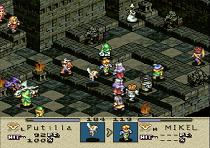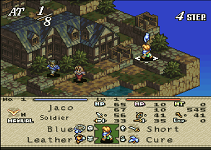Tactics Ogre
PlayStation
Reviewed: 10/26/09
Tactics Ogre is a game almost any RPG fan will feel familiar with, as the popular Final Fantasy Tactics is often dubbed Tactics Ogre‘s “spiritual sequel.” And there is much truth in this label. The games were both written and planned by the same people, they feature the same type of gameplay, similar settings, and similar moods. They both follow a blonde haired protagonist, his sister, and his dark haired best friend. They both do errands and fight bandits for a duke for a while. There are other similarities, but they’re more fun to spot on one’s own.
The game’s story is much more political than the average RPG, having largely to do with an ethnic war between Gargastan, Walsta, and Bacrum, as well as the corrupt leaders which perpetuate it. Denim forms an alliance with a strange foreigner who shares a name with his greatest enemy, and together they rescue Duke Ronway, the leader of the Walstanians, of whom Denim is a part. This sets off a series of events involving non-intervention treaties and false flag operations and inheritance disputes which test the faiths of the characters in their countries.
This story actually has three paths to go through, named after the D&D-esque alignments that they imbue Denim with — Law, Neutral, and Chaos. The path is decided by the player at specific points in the game. While all three paths end in the same place and converge for the final chapter, they heavily influence the course of the game, changing the locations of battles, which villains live or die, and which characters join the party, allowing for a lot of replay value. An interesting thing about this game compared to other tactical RPGs is the activity of the supporting characters. Often, they’ll show up in cutscenes and have a line or two — somewhat a rarity in the genre. Overall, the story can get rather complex, and it is definitely engaging once the first major plot decision comes up.
Gameplay in Tactics Ogre works like it does in many other strategy RPGs. One picks out a group of soldiers and sends them to fight. Most soldiers can change from a variety of classes, although the availability of classes depends on the character’s stats and alignment. Classes are nonrestrictive, meaning that any class can equip anything that any other class can equip, except for magic, which only certain classes can use. Classes affect only stat growths, spell slots, natural defenses and movement types.
 |
| The graphics don’t amaze, but is that really ever the point of a tactical RPG? |
Once in battle, the move order is decided by a character’s weight. Herein lays a slight balance issue in the game; as players progress through the game, more and more powerful equipment becomes available, but this equipment generally weighs a significant amount. Equipping characters with the best equipment causes them to move sluggishly through the battlefield, always going after characters that are less equipped. Weight also affects the rate of the character’s dodge skill, so the character equipped with more armor will actually end up taking more damage, as he is unable to dodge as much. Thus, a player actually benefits from never buying newer equipment and going through the game with the things he is provided with from the beginning.
Death is permanent for most of the game, and the spells that bring a character back from the dead are sometimes easy to miss and somewhat impractical. This creates a lot of the game’s difficulty, as one is given absolutely no leeway. Once the HP counter reaches 0, the character is gone. This makes some of the rescue missions nearly impossible.
Many Tactics Ogre players will mention the game’s over-emphasis on character levels, and the need to use of the game’s inbuilt grinding system called “Training.” In training, the party is split in two, and the player controls both sides as they beat on each other battle to level up, free of death penalties. Enemies in the game scale their levels to that of the highest leveled character, and being one level below them, according to many, is catastrophic. These people are wrong.
While levels are certainly important, a skillful player can play this game training only when there’s a two level discrepancy between themselves and the highest character in the party, which happens quite rarely. However, training is an inbuilt safety net for those that cannot figure out a great way to beat the enemy, and while it is a bit boring to grind using it, it is definitely a useful tool.
 |
| Old school tactical RPG combat at its best. |
The graphics in this game are not amazing by any means. They’re made up of decently drawn landscapes and somewhat crudely drawn and animated sprites. The portraits of the characters can vary between unbearably ugly and well-drawn. The spell effects are nothing to write home about, and get extremely repetitive for the area of effect spells, which replay the animation over everything tile they affect… sometimes playing up to 32 times. There are also occasional graphical slowdowns during those spells, and also when a character shoots a bow, providing one is playing the Playstation version. If one is playing the SNES version, none of this happens.
Sound is also mediocre to below average. There are three death grunts in this game, the male “Uah,” the female “Aie,” and the monster “Uagh.” That is all. The sounds of splashing water, drawing weapons, falling rocks, or opening doors are only vaguely similar to what those sounds actually sound like. The music is actually pretty decent. While some songs are incredibly forgettable and boring, others are excellent for providing the atmosphere of battle, or suspense or whatever the particular song is aiming for at the moment.
Overall, this is a good game on many levels, although it is not without its flaws. The graphical slowdowns are a slight nuisance, and the gameplay’s balance issues can be a definite turn off because they make the game sometimes unnecessarily tough — especially as it is already unforgiving with its permanent deaths. The story is excellent, however, and it is definitely worth bearing with the difficulty to experience it. Its three branches provide for plenty of longevity and replay value.
-Ivan Taran
| Score Breakdown | ||
| Overall Great Out of 10 See our Review Criteria |
Gameplay | Very Good |
| Story | Legendary | |
| Graphics | Average | |
| Sound/Music | Average | |
| Replay Value | Excellent | |
| The Verdict: Eight | ||









